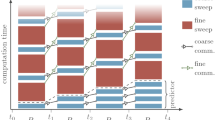Abstract
We study a class of general purpose linear multisymplectic integrators for Hamiltonian wave equations based on a diamond-shaped mesh. On each diamond, the PDE is discretized by a symplectic Runge–Kutta method. The scheme advances in time by filling in each diamond locally. We demonstrate that this leads to greater efficiency and parallelization and easier treatment of boundary conditions compared with methods based on rectangular meshes. We develop a variety of initial and boundary value treatments and present numerical evidence of their performance. In all cases, the observed order of convergence is equal to or greater than the number of stages of the underlying Runge–Kutta method.











Similar content being viewed by others
Notes
For example, for wide-stencil finite difference methods, a significant development effort over many years has yielded stable methods using the summation by parts and simultaneous approximation term approaches [3, 6, 12, 19]. These finite difference operators approximate ux (resp. uxx) at all points, using different finite differences near the boundary. Stability is achieved by requiring that the finite difference is skew- (resp. self-) adjoint with respect to an inner product, designed along with the method.
References
Amdahl, G.M.: Validity of the single-processor approach to achieving large scale computing capabilities. AFIPS Conference Proceedings 30, 493–485 (1967)
Bridges, T.J., Reich, S.: Numerical methods for Hamiltonian PDEs. J. Phys. A 39, 5287–5320 (2006)
Carpenter, M., Gottlieb, D., Abarbanel, S.: Time-stable boundary conditions for finite-difference schemes solving hyperbolic systems: methodology and application to high-order compact schemes. J. Comput. Phys. 111, 220–236 (1994)
Gough, B., Galassi, M.: GNU Scientific Library Reference Manual, Network Theory Ltd 3 Ed. (2009)
Jones, E., Oliphant, T., Peterson, P.: SciPy: Open source scientific tools for Python. http://www.scipy.org/ (2001)
Kreiss, H., Scherer, G.: On the Existence of Energy Estimates for Difference Approximations for Hyperbolic Systems, Tech. Report, Technical Report, Dept. of Scientific Computing, Uppsala University (1977)
Leimkuhler, B., Reich, S.: Simulating Hamiltonian Dynamics, Cambridge Monogr. Appl. Comput. Math. Cambridge University Press, Cambridge (2004)
McLachlan, R., Sun, Y., Tse, P.: Linear stability of partitioned runge–Kutta methods. SIAM J. Numer. Anal. 49, 232–263 (2011)
McLachlan, R.I., Sun, Y., Ryland, B.: High order multisymplectic runge–Kutta methods. SIAM J. Sci. Comput. 36, A2199–A2226 (2014)
McLachlan, R.I., Wilkins, M.: The multisymplectic diamond scheme. SIAM J. Sci. Comput. 37, A369–A390 (2015)
Moré, J.J., Garbow, B.S., Hillstrom, K.E.: User Guide for MINPACK-1, ANL-80-74 Argonne national laboratory (1980)
Olsson, P.: Summation by parts, projections, and stability. I. Math. Comput. 64, 1035–1065 (1995)
Powell, M.J.D.: An efficient method for finding the minimum of a function of several variables without calculating derivatives. Comput. J. 7, 155–162 (1964)
Reich, S.: Multi-symplectic runge–Kutta collocation methods for Hamiltonian wave equations. J. Comput. Phys. 157, 473–499 (2000)
Ryland, B.: Multisymplectic integration, PhD thesis, Massey University, New Zealand (2007)
Ryland, B.N., McLachlan, R.I.: On multisymplecticity of partitioned runge–Kutta methods. SIAM J. Sci. Comput. 30, 1318–1340 (2008)
Ryland, B.N., Mclachlan, R.I., Frank, J.: On the multisymplecticity of partitioned runge–Kutta and splitting methods. Int. J. Comput. Math. 84, 847–869 (2007)
Sun, Y.: Quadratic invariants and multi-symplecticity of partitioned runge–Kutta methods for Hamiltonian PDEs. Numer. Math. 106, 691–715 (2007)
Svärd, M., Nordström, J.: Review of summation-by-parts schemes for initial-boundary-value problems. J. Comput. Phys. 268, 17–38 (2014)
Funding
This research was supported by the Marsden Fund of the Royal Society Te Ap\(\bar {\mathrm {a}}\)rangi and by a Massey University PhD Scholarship.
Author information
Authors and Affiliations
Corresponding author
Additional information
Publisher’s note
Springer Nature remains neutral with regard to jurisdictional claims in published maps and institutional affiliations.
Rights and permissions
About this article
Cite this article
Marsland, S., McLachlan, R.I. & Wilkins, M.C. Parallelization, initialization, and boundary treatments for the diamond scheme. Numer Algor 84, 761–779 (2020). https://doi.org/10.1007/s11075-019-00778-8
Received:
Accepted:
Published:
Issue Date:
DOI: https://doi.org/10.1007/s11075-019-00778-8




